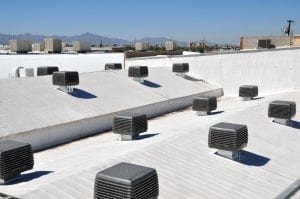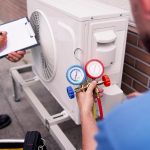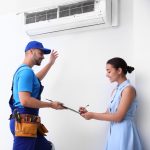8 tactics to monitor and maintain Indoor Air Quality (IAQ)
- Australia, Europe
- Commercial
- Community, Sustainability, FAQ’s & Tips, Health and Wellbeing
Monitoring and improving Indoor Air Quality (IAQ) is a critical responsibility for businesses, governments, and individuals alike. Poor IAQ can lead to a range of health issues, from respiratory problems and allergies to more severe conditions like asthma or even cardiovascular disease. Beyond health concerns, IAQ directly impacts cognitive function, energy levels, and overall well-being, making it a vital factor in enhancing productivity and comfort in workspaces, public environments, and homes. In an era where people spend a significant portion of their time indoors, ensuring clean and healthy air is essential not only for protecting public health but also for contributing to broader sustainability goals.
Proactive IAQ management is increasingly recognized as a cornerstone of building design and operations, particularly as governments implement stricter air quality regulations and consumers demand healthier indoor environments. Whether in commercial, industrial, or residential settings, poor air quality can result in costly absenteeism, decreased tenant satisfaction, and long-term negative health impacts. By taking deliberate measures to monitor and improve IAQ, stakeholders can not only mitigate these risks but also create environments that foster long-term health, well-being, and efficiency. With the advent of smarter technologies and innovative building management systems, monitoring and enhancing IAQ has never been more accessible or effective.
These proactive steps can help mitigate risks and promote long-term health.
- Implement Regular Monitoring Systems:
- IAQ Sensors: Install advanced sensors that continuously monitor pollutants such as CO2, PM2.5 (fine particulate matter), VOCs (volatile organic compounds), and humidity levels. These real-time sensors provide valuable data, enabling immediate responses to any IAQ concerns.
- Air Quality Audits: Conduct regular audits to assess the overall IAQ. Professional assessments or portable monitoring devices can help identify sources of contamination and offer actionable insights for improvement.
- Utilise Smart Building Management Systems:
- Integrated HVAC Controls: Leverage smart building systems that dynamically adjust ventilation, temperature, and humidity based on real-time IAQ data. These systems can automatically respond by increasing airflow or purifying air when pollutant levels rise.
- Data Analytics: Use data analytics to track IAQ trends over time, predict potential problems, and optimize building systems for energy efficiency and air quality. Predictive analytics enables preventive actions, avoiding costly IAQ issues.
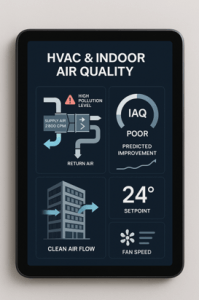
- Incentivise IAQ Improvements:
- Certification Programs: Pursue globally recognized certifications such as WELL Building Standard, NABERS, LEED, or BREEAM. These standards emphasize IAQ, helping boost property value, attract eco-conscious tenants, and support healthier workspaces.
- Employee and Tenant Education: Engage occupants by educating them on the importance of IAQ. Encourage behaviors like minimizing VOC-emitting products, improving ventilation practices, and reporting IAQ concerns.
- Health and Productivity Initiatives: Link IAQ improvements to wellness programs, health benefits, and green building initiatives. Demonstrating the link between better air quality and increased productivity can motivate businesses to prioritize air quality.

- Promote and Use IAQ-Enhancing Technologies:
- Air Purifiers and Filters: Invest in high-efficiency particulate air (HEPA) filters and advanced air purifiers to remove fine particles and harmful pollutants. This technology is particularly effective in areas with high pollution levels or during air pollution events.
- Green Building Materials: Promote the use of low-VOC and non-toxic paints, adhesives, and materials in construction and renovation projects. These materials minimize indoor pollution and contribute to a healthier environment from the outset.
- Engage in Preventive Maintenance:
- HVAC System Maintenance: Regularly service HVAC systems to ensure they do not contribute to indoor air pollution. This includes cleaning ducts, replacing filters, and addressing leaks or malfunctions that could degrade air quality.
- Ventilation System Checks: Perform regular checks of ventilation systems to ensure they are balanced and provide adequate fresh air intake while efficiently exhausting indoor pollutants.
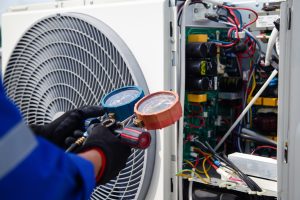
- Leverage Government and Industry Support:
- Subsidies and Grants: Governments often provide financial support for IAQ-related upgrades, such as HVAC improvements or the installation of monitoring equipment. Take advantage of these incentives to offset costs.
- Industry Best Practices: Stay informed about guidelines from authoritative bodies such as ASHRAE and the WHO. Adopting these best practices ensures alignment with the latest IAQ standards and helps maintain optimal indoor air environments.
- Prioritize IAQ in Future Building Design:
Planning for IAQ from the very beginning of a building project ensures long-term success. By embedding IAQ considerations into the design, construction, and operation phases, you can maximize sustainability, health, and energy efficiency. Incorporating standards like WELL, LEED, and BREEAM helps guide the development process, ensuring that buildings are not only efficient but also safe and healthy for occupants.’
- Harness Building Performance Tools and Certifications:
Building performance tools and accreditation systems, such as the WELL\LEED\Green Star\NABERS, are essential in driving improvements in IAQ and overall building sustainability. These standards provide a structured framework to measure performance across health, well-being, efficiency, and sustainability metrics.
Seeley International plays a crucial role in supporting high-efficiency standards through its technologies, such as the Climate Wizard, which is instrumental in improving IAQ and assisting with buildings criteria to achieve certifications. Climate Wizard technology, which provides high-efficiency cooling at very low energy consumption, is a key component in elevating building IAQ and aiding certification criteria for these global standards.
These building accreditation programs exemplify a “people-first” approach, prioritizing occupant health and well-being through innovative design, material selection, and air quality technologies.
By integrating these strategies, businesses, property owners, and government bodies can foster a healthier indoor environment while benefiting from higher occupant satisfaction, improved productivity, and potentially reduced healthcare costs related to poor IAQ. Addressing IAQ is not just a health imperative but a strategic investment in the well-being and success of people and space alike.

